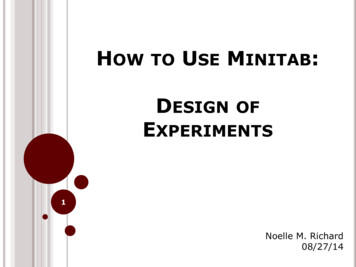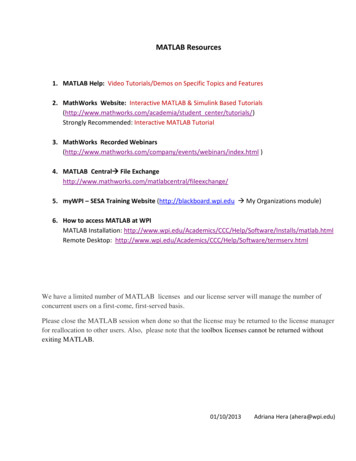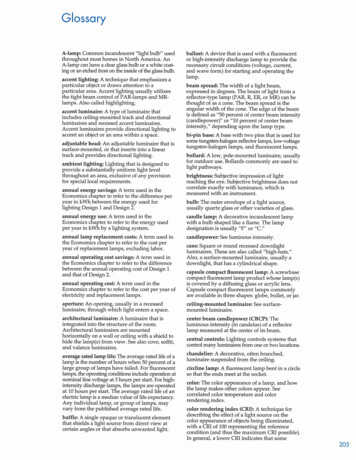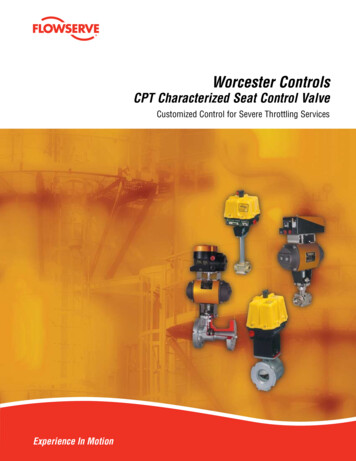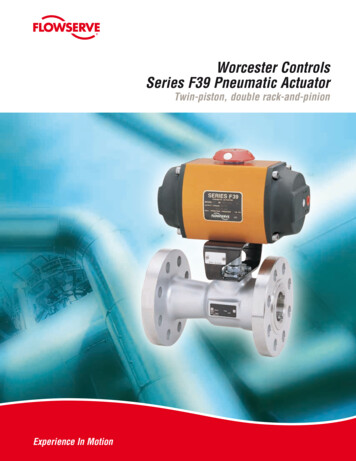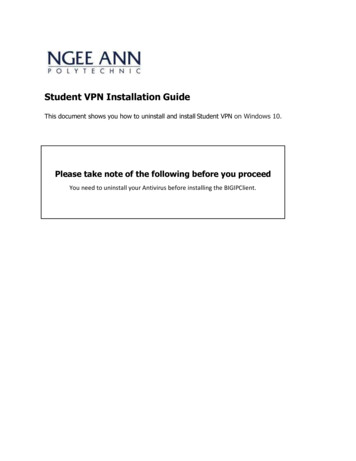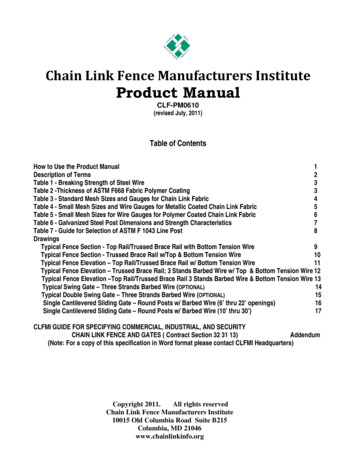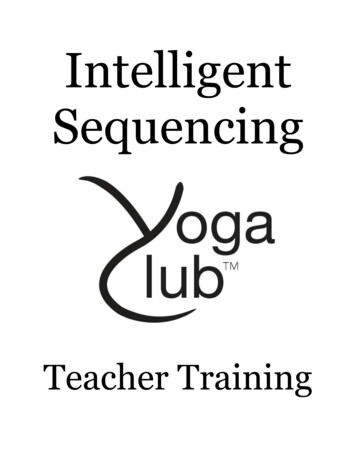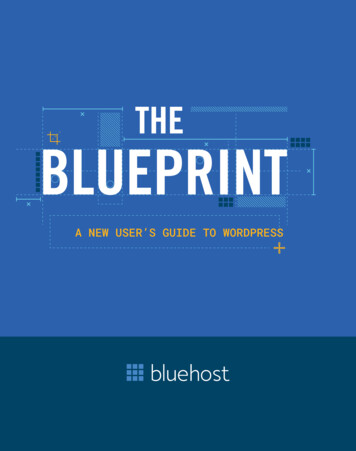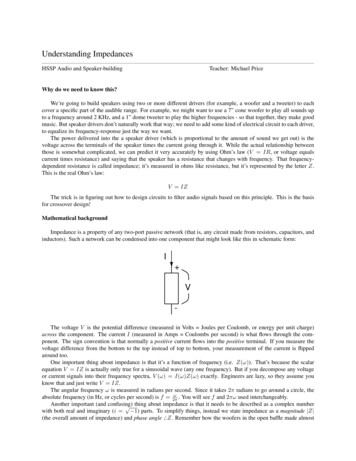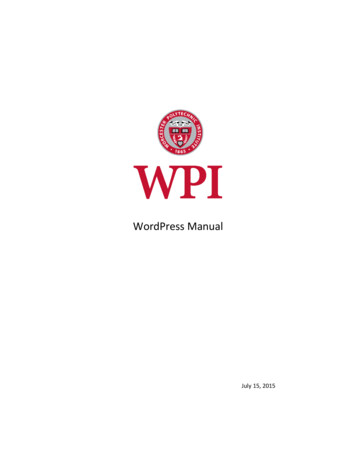
Transcription
WordPress ManualJuly 15, 2015
Table of ContentsWho should use this manual. 3Users . 3New Users: Creating an Account . 3Administrator: Adding Users . 3Signing into WordPress . 4The WordPress Dashboard and Left-Hand Navigation Menu. 4Pages vs. Posts . 5Adding & Editing Your Web Pages . 5The WordPress Editor & Toolbar . 7Adding & Editing Your Blog Posts . 8Blog Categories & Tags . 8Comments . 9Adding Photos and Documents to the Media Library. 10Uploading Images . 10Uploading Documents . 10Updating your Web Site Menus . 11Menu Settings . 11Links . 12Sidebar Widgets . 122
Who should use this manualThis document contains basic information for editing a WordPress web site and pertains to anyone whois maintaining a WPI WordPress site. However, your web site may contain specific theme-relatedfunctionality which is not covered in this document. If this is the case, you should’ve received a separatedocument with the extra instructions for your theme.UsersNew Users: Creating an Account1. First time users must click on the LOG IN link at the top of the main WordPress page:http://wp.wpi.edu/2. Log in with your WPI username and password.3. After logging in, notify the administrator so they can add you as a user to the web site.Administrator: Adding UsersOnce a user has logged in, they will be added to the global WordPress users list. To add them to yoursite:1. Click on the Users menu from the left-hand navigation bar.2. DO NOT user the “Add New” option from the menu.3. Instead, click on the “Add Existing” button at the top of the page.4. Enter the user’s email address into the box and select the appropriate role: Administrator – somebody who has access to all the administration features within a single site. Editor – somebody who can publish and manage posts including the posts of other users. Author– somebody who can publish and manage their own posts. Contributor – somebody who can write and manage their own posts but cannot publish them.The user will be sent an email letting them know that they have been added as a user to the web site.3
Signing into WordPressTo access the login page in WordPress, add “/wp-admin” to the end of your web site name. Forexample: dmin.You will see the familiar WPI login screen as shown below. Use your WPI credentials to sign into yourWordPress web site.4
The WordPress Dashboard and Left-Hand Navigation MenuUpon logging in, the first screen that you will see is called the Dashboard screen. The Dashboardprovides a quick overview of your web site – the number of blog posts, web pages, comments, spam,etc. You can click on any of these items to go directly to that section of the admin.The left-hand navigation menu is the main way to navigate through the WordPress Admin. This menuappears to the left on every Admin page and each section is expandable. Below is a brief description ofeach of these sections:1.2.3.4.5.6.7.8.9.10.Dashboard – click on this menu item anytime you want to return to this main screen.Posts – this is where your blog articles are. Your web site may or may not have a blog.Media – the media library stores all photos and documents that you’ve uploaded to your web site.Links – this section is used to add links to other web sites, which can be displayed in a sidebar widgetPages – this is where you create and edit your web site pages.Comments – if you have a blog & comments are turned on, this is where you would go to moderateyour commentsAppearance – this is where you manage your sidebar widgets, your menus, and possibly your themesettings (depending upon the theme)Users – this is where you can grant access to new users or modify your profileTools – most users will never need anything listed under tools, unless you want to export your siteto XML or permanently delete your site (be careful – once deleted you cannot get it back!)Settings – this is where your WordPress settings are saved.Note: If your menu has more options than this, the additional sections are specific to your theme andwill be covered in a different manual.4
Pages vs. PostsTo new WordPress users, the difference between pages and posts can be confusing. Pages refers toyour web pages and Posts refers to your blog articles. You may only have pages on your web site, justposts, or sometimes both. The main distinction is how the blog articles are organized using Categoriesand Tags, which are briefly discussed later on in this document.Adding & Editing Your Web PagesClick on Pages in the sidebar menu to access your web pages.The Pages Screen lists all of your existing pages. If you hover over the title of a web page, a menu will appear beneath the title that allows youto: Edit, Quick Edit, Trash or View.Edit will bring you to the WordPress editor so you can make changes to the pageQuick Edit allows you to modify some of the parameters for this page, but not the contentTrash will delete the pages (note that it goes into the trash & is not permanently deleted)View allows you to view the web page To add a new page, click on the “Add New” button at the top of the page OR from the leftNavigation menu.5
Whether you are adding a new web page or editing a page, the process is exactly the same.1. First you add a title for your web page. It’s important to put keywords into your title to make it clearto your readers and the search engines what this page is about.2. Then you add the content to the text editor.3. Under Page Attributes in the right sidebar, you can specify a parent page. This helps to betterorganize your content so that you can find related pages (otherwise content is displayedalphabetical). Depending upon your theme, you may also need to select a template (this would bespecified in your theme manual). Most web pages will use the default template.4. Make sure you press the Publish (or Update) button to save your changes!6
The WordPress Editor & ToolbarBelow is a close-up of the toolbar at the top of the WordPress editor. If you are only seeing one row oficons, click on the “show/hide kitchen sink” button that is circled in green below.Most of these buttons should look very familiar. Just like Microsoft Word or any other word processingprogram, you can add bold text, italic text, bullets, numbered lists, etc. just by clicking the buttons inthe toolbar.Hyperlinks:These 2 chain link icons are for creating & removing hyperlinks. These buttons are grayed outuntil you highlight a word that you want to format. You can click on the first icon if you want to create anew hyperlink. This could be to another page within your web site or to a page on another web site. Abox will open up allowing you to specify the link. If you are linking to a different web site, make sure youclick on the button that says to open the link in a new window. If you want to remove a link, just putyour cursor on an existing hyperlink and click the broken link icon.Add Media Button: The Add Media button button allows you to upload photos and documents to your web page.Visual vs Text Tabs: On the far right side of the editor you’ll notice 2 tabs at the top: Visual and Text. Most peopleshould only use the Visual Tab. If you are seeing HTML code in the editor, you are probably in TextEdit mode and need to change tabs. Unless you are very comfortable editing HTML code, Irecommend that you only use the Visual Tab.7
Adding & Editing Your Blog PostsNote: If your web site does not have a blog, you can skip to Adding Photos and Documents to the MediaLibrary Section!The great thing about WordPress is that its interface is very consistent. So if you just finished readingthe section above on Adding & Editing Your Web Pages, then this section will seem like a review. Thereare however a few “extra” things that you need to do when adding a blog post.Click on Posts in the sidebar menu to access your blog posts. The Posts Screen lists all of your existingblog posts. Just like with a web page, if you hover over the title a menu will appear. Click on the Editlink to edit the blog post. Or Click on the Add New button at the top to add a new Blog Post.Whether you are adding a new blog post or editing an existing blog post, the process is exactly the same.1.2.3.4.5.6.First you add a title for your blog article.Then you add the conent to the text editor.For a blog article, you need to choose a category for the article to appear in.You should also specify tags for your article (More information on Categories & Tags below)If your theme uses Excerpts, you can specify a shortened version of the article in the Excerpts box.Make sure you press the Publish (or Update) button to save your changes!Blog Categories & TagsCategories and tags allow you to organize your blog content to make it easier for readers to findinformation that is relevant to them. In describing categories and tags, it is helpful to think of a bookanalogy. The Categories represent the Chapters of a book and the Tags represent the Index.When you are starting a new blog, it is important to brainstorm about the types of articles you plan towrite and come up with no more than 10 or 12 categories that will represent all of your blog topics. Too8
many categories can make your blog difficult to navigate. You can always add a new category later, butit’s preferable to correctly set up your blog categories right from the start than it is to re-organize all ofyour blog articles at a later date.Where your categories should be broad topic areas, your tags can be much more narrow in focus. Likethe index in the back of a book, your tags represent sub-topics within the main category.For example, a blog that is focused on Mechanical Engineering may choose to have 10 categories – onefor each of the 9 Concentration Areas and a 10th category that is more general and relates to allMechanical Engineering disciplines. An article within the Aeronautics Category may have tags for NASA,space flight, and trajectory analysis (depending upon the subject matter of the article.)Note that WordPress uses this information to create additional pages on your web site, grouping relatedinformation together. So you end up with not only individual blog articles pages, but also pages for eachof your categories and all of your tags. However, your theme must be set up with the appropriatetemplates in order to display these pages.Adding Categories & Tags to your Blog Articles: You can add new categories & tags either from thePosts menu in the left-hand navigation menu or directly in the WordPress editor as you are creatingyour blog articles (see the Categories & Tags boxes in the right sidebar.) Existing categories & tags willalready be listed for you to choose from.CommentsIf your blog is set up to accept comments, the web site admin will receive an email every time someoneposts a comment. Comments are set up for mediation, such that the administrator needs to log into theweb site and approve the comment. You can also reply to a comment, trash a comment or mark it asSpam.To see the comments on your blog, click on the Comments menu in the left-hand navigation.9
Adding Photos and Documents to the Media LibraryIf you click on Media in the left navigation menu, you will see all of the photos that are on your web siteand possibly some documents. You can click on the “Add New” button at the top of the Media page orchoose “Add New” from the left-hand menu, but it is usually easier to just upload documents andimages while you are editing a web page or blog post. Everything that you upload into WordPress isstored in your Media Library and can be re-used as needed.When editing a web page or blog post, you’ll notice the “Add Media” button directly above theWordPress editor.Uploading ImagesIf you click on this button, it will open up a window that allows you to either select a photo from theMedia Library or Upload a new file. Notice the 2 links at the top of the page that lets you indicate whereyou want to select the photo from.If you want to upload a photo from your computer, click on the Select Files button and navigate to thephoto you want to upload. Once the file has been uploaded, you are given a few options to choose frombefore inserting the image into your page. You can choose the photo alignment in relation to the text(left, right or centered); you can choose to link the photo to a URL (note that the default link is to thephoto itself – which I usually delete); and you can select the image size. You can also add a caption andsome meta data (description and alt text) to the photo.Uploading DocumentsThe process is pretty much the same for uploading a document. Click on the “Add Media” button. Clickthe link to “Upload Files.” Navigate to the file you want to upload and click Open. The file will beuploaded to your web site. Before clicking on the button to “Insert into Page,” change the Title text towhatever you would like the link to say on your web page.10
Updating your Web Site MenusWhen you add a new page to your web site, you will need to update the web site menu. Note that thisonly pertains to New Pages and not new blog posts.Under the Appearance Menu, select Menus. This will bring you to a page as shown below.1. At the top of the page, select the menu that you would like to edit. Note that your web site mayonly have one menu.2. Check the box next to the page you want added to the menu and click the “Add to Menu” button.3. The new page will be added to the bottom of the menu structure. You can use your mouse to dragthe new page to a different location in the menu. If you drag it below and to the right of anotherweb page, it will create a submenu. Note that your theme has to have the appropriate coding inorder for sub-menus to work. You can also expand each of these menu items and adjust settings,such as the Navigation label.4. When you are finished, make sure you click the “Save Menu” button to save your changes and makethem live on the web site.Important: You want to use the Pages section to add pages to your menu and not the Links section.Both will allow you to add web pages to your menu, but Pages will link the menu to the page ID insteadof the page URL. If someone changes the URL, the page IDs will continue to work but page URLs willbreak.Menu SettingsAt the bottom of the Menus page, there are some Menu settings. We do not recommend that youcheck the box to automatically add new top-level pages to a menu, especially if you have a horizontalmenu bar which can only fit about 8 or so options across the top.11
LinksYou can also use WordPress menus to create a list of related web site links. Create a new menu and usethe Links Section at the left to add URLs. After saving your menu, go to Appearance - Widgets and adda Custom Menu widget to your Sidebar. Expand the widget and select the new menu that you created.Sidebar WidgetsMost of the content that you see in your sidebar is contained in what’s called a Widget.From the Appearance Menu, select Widgets.On the left side of the screen are the available widgets you can use in your sidebar. On the right side ofthe screen are the sections of your web site that you can drag widgets into.The most commonly used widget is the text widget. Although the text widget can be used for just plaintext, it is often used for both text and HTML code. If you are not familiar with HTML code, be carefulwhen you are editing your text widgets. One small error in a sidebar can break the code for the entireweb page.If you have a blog installed, you may see widgets in your sidebar for Recent Posts, Featured Post,Comments, and Categories.12
Jul 15, 2015 · Note that WordPress uses this information to create additional pages on your web site, grouping related information together. So you end up with not on ly individual blog articles pages, but also pages for each of your categories and all of your tags. However, your theme must be set up with t
